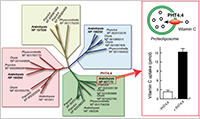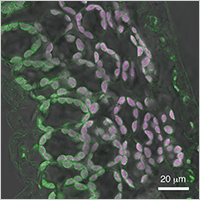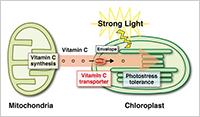(Left) Phylogenetic tree of the plant PHT4 family. (Right) Vitamin C uptake by proteoliposomes containing AtPHT4;4 or no AtPHT4;4.
Enlarge Image Figure 2. AtPHT4;4 is abundantly expressed in the envelope membranes of chloroplasts from the leaves of Arabidopsis.
The fluorescence signals of AtPHT4;4 and chlorophyll are shown in green and magenta, respectively.
Enlarge Image Figure 3. The mechasism of vitamin C transport in chloroplast.
Upon strong light, the PHT4;4 at the envelope membranes takes up vitamin C from mitochondria, which is required for photostress tolerance.
Enlarge Image
Vitamin C transport in plants: AtPHT4;4 required for photo-inhibition tolerance
Vitamin C (ascorbate) is an antioxidant and coenzyme for a number of metabolic reactions in living organisms. In plant chloroplasts, high vitamin C levels are required to overcome photo-inhibition caused by strong light.
Although vitamin C is synthesized in the mitochondria, the molecular mechanisms underlying vitamin C transport into chloroplasts are poorly understood.
Now, Takaaki Miyaji, Yoshinori Moriyama, and Jian Feng Ma at Okayama University, together with Takashi Kuromori at RIKEN and colleagues, have shown that AtPHT4;4, a member of the phosphate transporter 4 family of Arabidopsis thaliana, functions as a vitamin C transporter.
The team found that proteoliposomes containing purified AtPHT4;4 protein exhibited membrane potential (ΔΨ)- and Cl--dependent vitamin C uptake (Fig. 1). AtPHT4;4 protein was expressed abundantly in the chloroplast envelope membranes (Fig. 2). Knocking out AtPHT4;4 resulted in decreased levels of vitamin C in the chloroplasts. The heat dissipation process of excessive energy during photosynthesis also decreased in the mutants.
These results indicate that AtPHT4;4 protein is a vitamin C transporter at the envelope membranes of chloroplasts, which is required for tolerance to strong light stress (Fig. 3). This is the first report regarding the identification of a vitamin C transporter in plants.
This research could help guide the development of heritable transporter genetic modification technology, which may provide a means of developing photo-inhibition tolerant plants.
References
・Takaaki Miyaji1, Takashi Kuromori2, Yu Takeuchi3, Naoki Yamaji4, Kengo Yokosho4, Atsushi Shimazawa3, Eriko Sugimoto2, Hiroshi Omote3, Jian Feng Ma4, Kazuo Shinozaki2 and Yoshinori Moriyama1,3
・AtPHT4;4 is a chloroplast-localized ascorbate transporter in Arabidopsis
・Nature Communications 6, DOI: 10.1038/ncomms6928 (2015)
・http://www.nature.com/ncomms/2015/150105/ncomms6928/full/ncomms6928.html
・1Advanced Science Research Center, Okayama University. 2Gene Discovery Research Group, RIKEN Center for Sustainable Resource Science. 3Department of Membrane Biochemistry, Okayama University Graduate School of Medicine, Dentistry and Pharmaceutical Sciences. 4Institute of Plant Science and Resources, Okayama University.
News&Views
・Foyer C.H. Redox homeostasis: Opening up ascorbate transport.
Nature Plants 1, DOI: 10.1038/nplants.2014.122 (2015).
http://www.nature.com/articles/nplants201412
Spotlight
・Fernie A.R., Tóth S.Z. Identification of the elusive chloroplast ascorbate transporter extends the substrate specificity of the PHT family. Molecular Plants 8 (5) 674-676 (2015).
http://www.cell.com/molecular-plant/abstract/S1674-2052(15)00134-3



